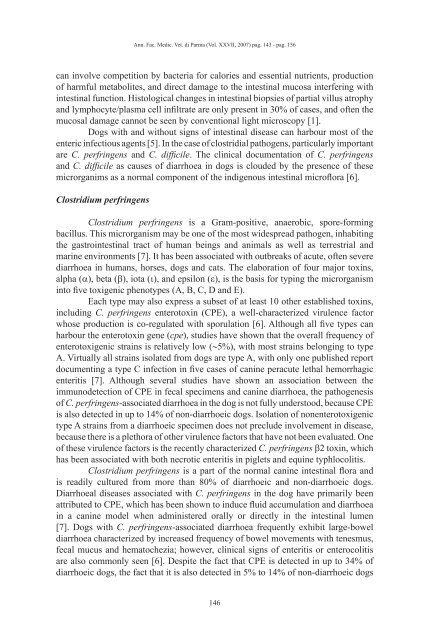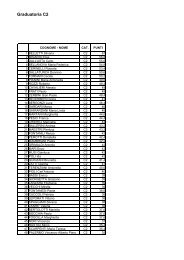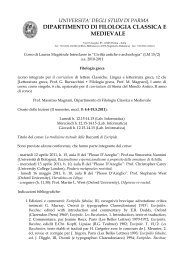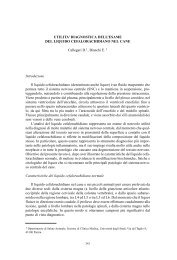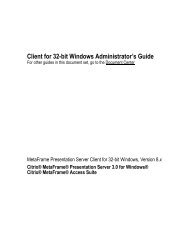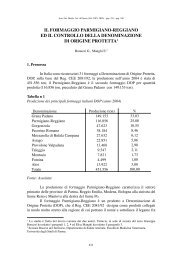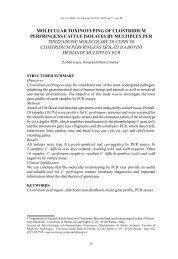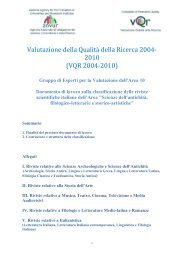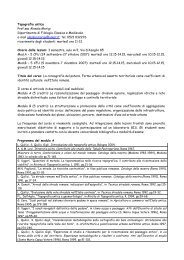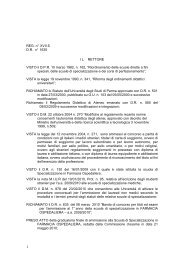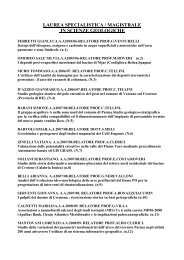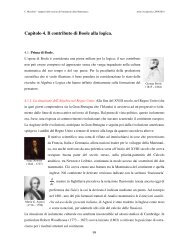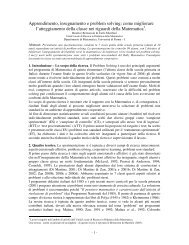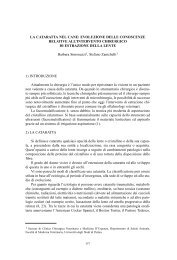Prevalence of Clostridium sPP. in diarrhoeic and healthy dogs ...
Prevalence of Clostridium sPP. in diarrhoeic and healthy dogs ...
Prevalence of Clostridium sPP. in diarrhoeic and healthy dogs ...
Create successful ePaper yourself
Turn your PDF publications into a flip-book with our unique Google optimized e-Paper software.
Ann. Fac. Medic. Vet. di Parma (Vol. XXVII, 2007) pag. 143 - pag. 156can <strong>in</strong>volve competition by bacteria for calories <strong>and</strong> essential nutrients, production<strong>of</strong> harmful metabolites, <strong>and</strong> direct damage to the <strong>in</strong>test<strong>in</strong>al mucosa <strong>in</strong>terfer<strong>in</strong>g with<strong>in</strong>test<strong>in</strong>al function. Histological changes <strong>in</strong> <strong>in</strong>test<strong>in</strong>al biopsies <strong>of</strong> partial villus atrophy<strong>and</strong> lymphocyte/plasma cell <strong>in</strong>filtrate are only present <strong>in</strong> 30% <strong>of</strong> cases, <strong>and</strong> <strong>of</strong>ten themucosal damage cannot be seen by conventional light microscopy [1].Dogs with <strong>and</strong> without signs <strong>of</strong> <strong>in</strong>test<strong>in</strong>al disease can harbour most <strong>of</strong> theenteric <strong>in</strong>fectious agents [5]. In the case <strong>of</strong> clostridial pathogens, particularly importantare C. perfr<strong>in</strong>gens <strong>and</strong> C. difficile. The cl<strong>in</strong>ical documentation <strong>of</strong> C. perfr<strong>in</strong>gens<strong>and</strong> C. difficile as causes <strong>of</strong> diarrhoea <strong>in</strong> <strong>dogs</strong> is clouded by the presence <strong>of</strong> thesemicrorganims as a normal component <strong>of</strong> the <strong>in</strong>digenous <strong>in</strong>test<strong>in</strong>al micr<strong>of</strong>lora [6].<strong>Clostridium</strong> perfr<strong>in</strong>gens<strong>Clostridium</strong> perfr<strong>in</strong>gens is a Gram-positive, anaerobic, spore-form<strong>in</strong>gbacillus. This microrganism may be one <strong>of</strong> the most widespread pathogen, <strong>in</strong>habit<strong>in</strong>gthe gastro<strong>in</strong>test<strong>in</strong>al tract <strong>of</strong> human be<strong>in</strong>gs <strong>and</strong> animals as well as terrestrial <strong>and</strong>mar<strong>in</strong>e environments [7]. It has been associated with outbreaks <strong>of</strong> acute, <strong>of</strong>ten severediarrhoea <strong>in</strong> humans, horses, <strong>dogs</strong> <strong>and</strong> cats. The elaboration <strong>of</strong> four major tox<strong>in</strong>s,alpha (α), beta (β), iota (ι), <strong>and</strong> epsilon (ε), is the basis for typ<strong>in</strong>g the microrganism<strong>in</strong>to five toxigenic phenotypes (A, B, C, D <strong>and</strong> E).Each type may also express a subset <strong>of</strong> at least 10 other established tox<strong>in</strong>s,<strong>in</strong>clud<strong>in</strong>g C. perfr<strong>in</strong>gens enterotox<strong>in</strong> (CPE), a well-characterized virulence factorwhose production is co-regulated with sporulation [6]. Although all five types canharbour the enterotox<strong>in</strong> gene (cpe), studies have shown that the overall frequency <strong>of</strong>enterotoxigenic stra<strong>in</strong>s is relatively low (∼5%), with most stra<strong>in</strong>s belong<strong>in</strong>g to typeA. Virtually all stra<strong>in</strong>s isolated from <strong>dogs</strong> are type A, with only one published reportdocument<strong>in</strong>g a type C <strong>in</strong>fection <strong>in</strong> five cases <strong>of</strong> can<strong>in</strong>e peracute lethal hemorrhagicenteritis [7]. Although several studies have shown an association between theimmunodetection <strong>of</strong> CPE <strong>in</strong> fecal specimens <strong>and</strong> can<strong>in</strong>e diarrhoea, the pathogenesis<strong>of</strong> C. perfr<strong>in</strong>gens-associated diarrhoea <strong>in</strong> the dog is not fully understood, because CPEis also detected <strong>in</strong> up to 14% <strong>of</strong> non-<strong>diarrhoeic</strong> <strong>dogs</strong>. Isolation <strong>of</strong> nonenterotoxigenictype A stra<strong>in</strong>s from a <strong>diarrhoeic</strong> specimen does not preclude <strong>in</strong>volvement <strong>in</strong> disease,because there is a plethora <strong>of</strong> other virulence factors that have not been evaluated. One<strong>of</strong> these virulence factors is the recently characterized C. perfr<strong>in</strong>gens β2 tox<strong>in</strong>, whichhas been associated with both necrotic enteritis <strong>in</strong> piglets <strong>and</strong> equ<strong>in</strong>e typhlocolitis.<strong>Clostridium</strong> perfr<strong>in</strong>gens is a part <strong>of</strong> the normal can<strong>in</strong>e <strong>in</strong>test<strong>in</strong>al flora <strong>and</strong>is readily cultured from more than 80% <strong>of</strong> <strong>diarrhoeic</strong> <strong>and</strong> non-<strong>diarrhoeic</strong> <strong>dogs</strong>.Diarrhoeal diseases associated with C. perfr<strong>in</strong>gens <strong>in</strong> the dog have primarily beenattributed to CPE, which has been shown to <strong>in</strong>duce fluid accumulation <strong>and</strong> diarrhoea<strong>in</strong> a can<strong>in</strong>e model when adm<strong>in</strong>istered orally or directly <strong>in</strong> the <strong>in</strong>test<strong>in</strong>al lumen[7]. Dogs with C. perfr<strong>in</strong>gens-associated diarrhoea frequently exhibit large-boweldiarrhoea characterized by <strong>in</strong>creased frequency <strong>of</strong> bowel movements with tenesmus,fecal mucus <strong>and</strong> hematochezia; however, cl<strong>in</strong>ical signs <strong>of</strong> enteritis or enterocolitisare also commonly seen [6]. Despite the fact that CPE is detected <strong>in</strong> up to 34% <strong>of</strong><strong>diarrhoeic</strong> <strong>dogs</strong>, the fact that it is also detected <strong>in</strong> 5% to 14% <strong>of</strong> non-<strong>diarrhoeic</strong> <strong>dogs</strong>146


